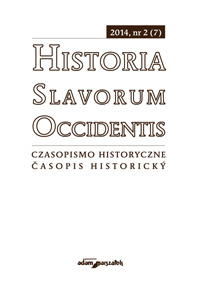Opowieść Kosmasa o Pięciu Braciach Męczennikach i jej potencjalne źródła
Cosmas' Tale of Five Martyr Brothers and its possible sources
A brief contribution to the discussion
Author(s): Marzena MatlaContributor(s): Agnieszka Tokarczuk (Translator)
Subject(s): Christian Theology and Religion, History, Middle Ages, Theology and Religion, 6th to 12th Centuries
Published by: Wydawnictwo Adam Marszałek
Keywords: Five Martyr Brothers;historiography;Cosmas’ chronicle
Summary/Abstract: Apart from the legend scribbled down by Bruno of Querfurt and a mention in the Life of St. Romuald by Peter Damian, the history of the martyrdom of Five Martyr Brothers, was also noted by a Czech chronicler Cosmas, even though is at variance with the other two stories. All manuscripts of the Cosmas’ chronicle contain wider information on Polish eremites, except for the Stockholm copy, that is to say a version in Codex Gigas, generally believed to be an unfinished copy of the edition of the chronicle prepared when Cosmas still alive. What was the basis of Cosmas version – whether it was a scholarly figment of his imagination, or, alternatively, a completion of copyists or information he based on oral sources or a written legend, which had arrived from Poland – has been a subject of much debate among the historians.The comparison of another fragment of the chronicle, which mentions the translocation of the relics of Five Martyr Brothers, seems to indicate that Cosmas completed the original version of his chronicle with a wider version of the legend himself. The analysis of chronological elements of the original version of Cosmas’ chronicle from the Stockholm Codex and later copies containing extensive descriptions devoted to the life of the Five Brothers suggests that apart from a more extensive legend, Cosmas also revised the chronology of events, thereby furnishing a more accurate dating in the second version (the day of death – 11th November, instead of the original 12th November), in accordance with the version of Bruno of Querfurt. Such dating is incompatible with the version that appears in the Czech and Polish calendars starting from the second half of the eleventh century, which means that Cosmas must have found it, along with an extensive legend, in a written version. The analysis of Czech calendars has shown that day of Five Martyr Brothers was not fi xed in Bohemia at the beginning of the twelfth century, which could have disposed Cosmas towards including a broader story of the Polish hermits (whose relics were stored in some Czech centres) in his chronicle, with a view to disseminating their worship.The legend itself, the one Cosmas grounded his story on, is likely to have originated in Bohemia, as evidenced by the unmistakable ignorance of either the Polish realities or the hermits’ life and was probably written down only after Bretislaus I brought the relics of the martyrs to Prague in1039, thereby creating a burning need for the legend which would disseminate the cult of new saints. This legend is based on oral tradition, formed by the Czech clergy (hitherto cooperating with Bolesław the Brave) coetaneous to the events, and, on the other hand, on an obituary record comprising the names and dates of the brothers and a day date, which could have arisen in Prague shortly after the events. This tradition also recorded the name of the sixth hermit, who escaped death owing to the deputation to Rome – it is reasonable to assume that the hermit frequented Prague to report the ruler with his deputations. Due to the collision of the day of the brothers’ martyrdom and St. Gregory of Tours, in the Czech calendars, the holiday was postponed for 12 November already in the second half of the eleventh century. Writing the first editorial of his chronicles, Cosmas had probably only vintages, vague oral tradition (which retains the name of Barnabas) and an updated calendar at his disposal, hence the manuscript of Stockholm lacks a broader description of the martyrs and 12th November as the date of their death. Before making the final editorial, Cosmas must have discovered a written version of the legend, produced after 1039, and under its influence included a more extensive description of events and the modified day date of hermits’ death.
Journal: Historia Slavorum Occidentis
- Issue Year: 2014
- Issue No: 2
- Page Range: 13-38
- Page Count: 26
- Language: Polish

